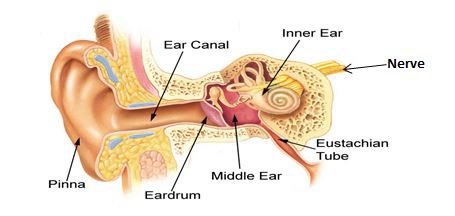Hearing loss in children and adults
19 March 2019
What is hearing loss?
Hearing loss is a symptom of a variety of conditions affecting the structures of the ear. It may be caused by problems affecting how sound travels to the inner ear, or due to problems in the inner ear or hearing nerve.

What causes hearing loss?
Conductive hearing loss is caused when something interferes with the transmission of sound to the inner ear. It can be due to problems in the ear canal, ear drum or the middle ear.
In children the commonest type of hearing loss is conductive hearing loss. This is usually due to fluid in the middle ear in a condition called glue ear. The fluid stops the eardrum from moving.
Sometimes there are other causes for childhood conductive hearing loss. Rarely children may be born with poorly formed middle ear bones, or these structures can be damaged through ear infection.
In adults conductive hearing loss is less common but may be due to problems with the middle ear bones or occasionally glue ear. Heavy wax accumulation in the ear canal can also cause a mild degree of conductive hearing impairment.
Sensorineural hearing loss is caused when there is a problem with the inner ear, or the hearing nerve.
What are the symptoms?
Newborn babies are screened at birth to identify babies with significant hearing loss. Occasionally hearing problems can develop when a child becomes older and can go undiagnosed for some time. This can have an effect on speech development and can cause educational concerns.
In children, parents find that they might be inattentive, or ignore instructions or appear naughty. Listening to the television at high volumes is common and sometimes the child’s teachers will complain. Young children with delayed speech production should always be assessed for hearing loss.
Most adults first start to notice difficulty in following conversation when there is background noise or when more than one person is talking. Often their friends will complain that they don’t listen or that they turn the television volume up too loud. They may become increasingly withdrawn and frustrated that they cannot socialise easily.
What should you do if you suspect hearing loss?
In most circumstances you should see your doctor, who will be able to examine you for wax impaction and look for signs of ear disease. Your doctor can then arrange hearing tests and if necessary review by an ENT consultant.
Referrals can be made by self-referral or via your GP.
What investigations and treatments are available for Hearing Loss?
Your doctor or specialist will arrange for you to have hearing tests performed. A variety of tests are available, and special test techniques can be used to assess children.
At Spire London East Hospital, we are pleased to offer hearing tests for Children from 7 months to 16 years of age. It is one of the few centres that provide this locally with a prompt service and highly experienced staff. We offer various tests that are tailored to the child’s developmental age to determine the hearing levels.
- VRA-Visual Reinforcement Audiometry: In this test the baby turns towards a toy that lights up when they hear a sound. It is suitable for children from 7 months old.
- Play Audiometry: In this test the child makes a response such as put a toy in a box each time a sound is made. It is testing the child’s hearing through a play method and is suitable from 2.5 years old.
- Pure Tone Audiometry: In this test the child makes a response by pressing a button when they hear a sound. It is suitable for children from 6 years old.
- Oto-Acoustic Emissions Testing: This tests the sensory cells of the inner ear. It is an automatic test used to assess inner ear function.
- Tympanometry: This test checks the middle ear status and to check if ‘Glue Ear’ is present.
Treatment depends on the severity of the hearing loss and whether it is conductive or sensorineural.
In conductive hearing loss there may be an infection or other disease process that needs to be treated. Treatment may include surgery, both to treat the infection and restore the hearing. Glue ear may be treated with surgery by the insertion of grommets.
In sensorineural hearing loss and in conductive hearing loss where surgery is not suitable, hearing aids will be advised. These come in different sizes and types to suit different users and hearing needs.
References and Acknowledgements:
- About Hearing Loss Patient Information leaflet ENT UK
- Pocket Tutor in Otolaryngology 2nd edition (2019) Authors: Bhattacharyya, Ifeacho & Zhang, Jaypee Publishers, UK, ISBN-10: 1909836885, ISBN-13: 978-1909836884

